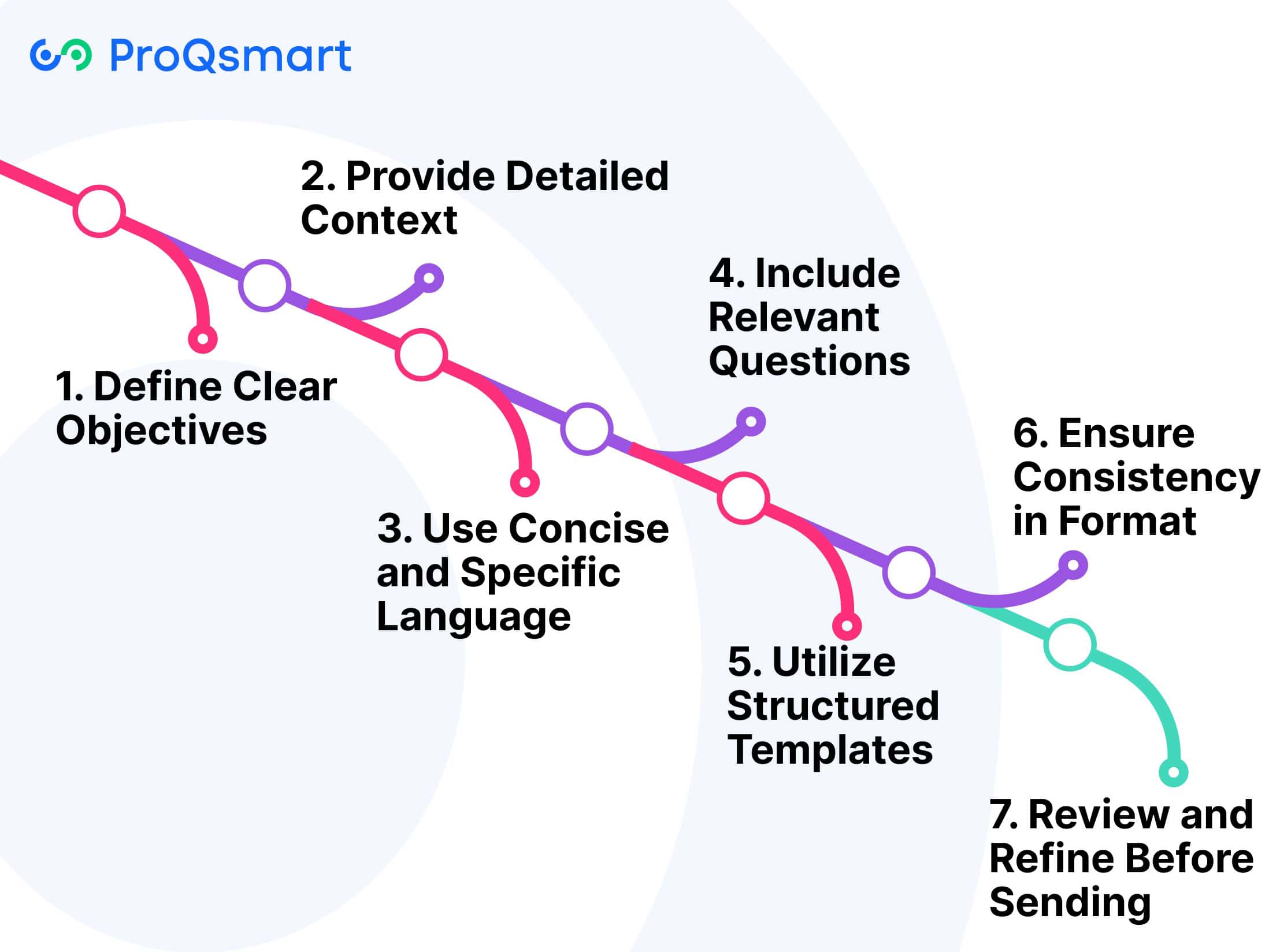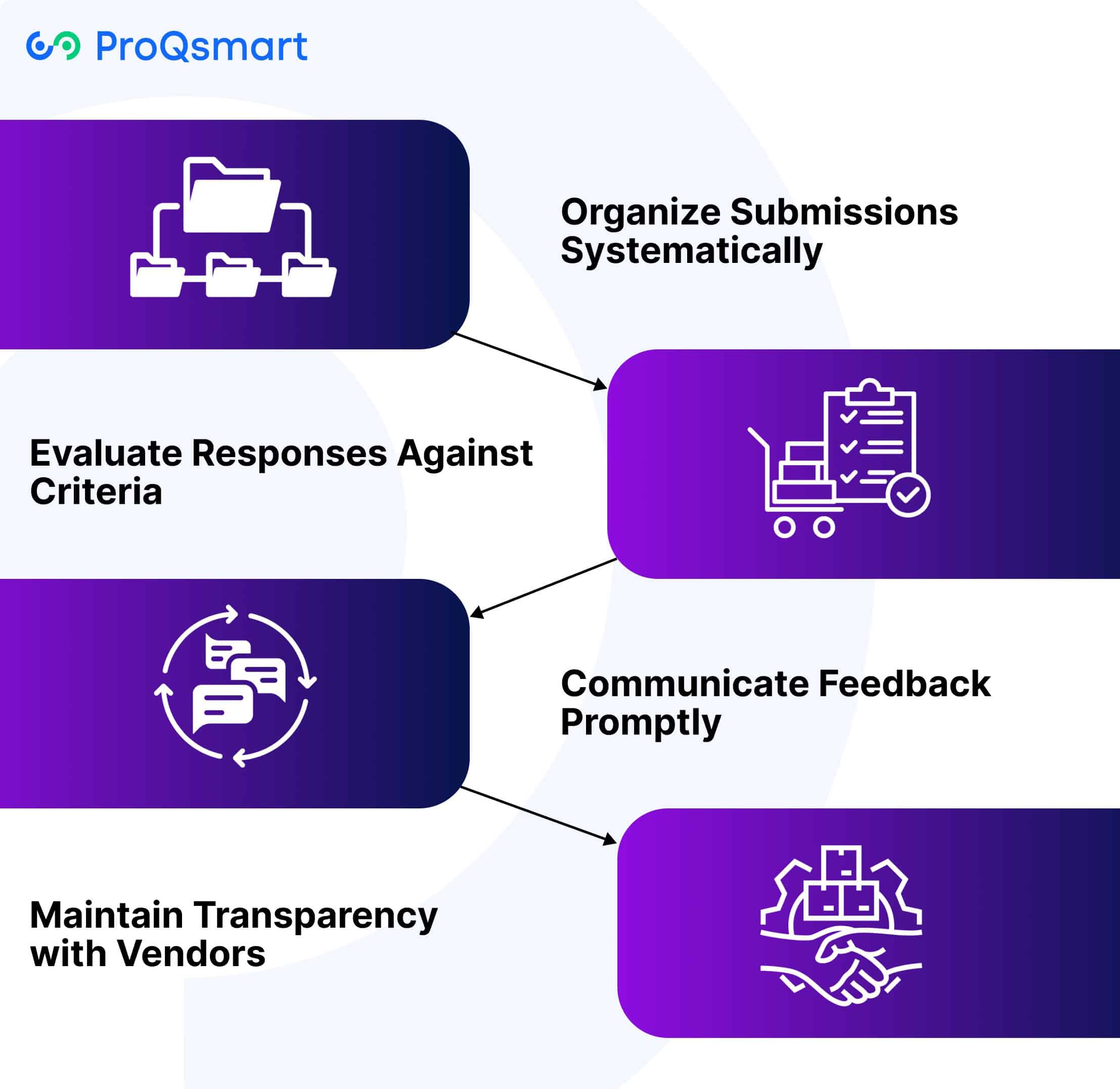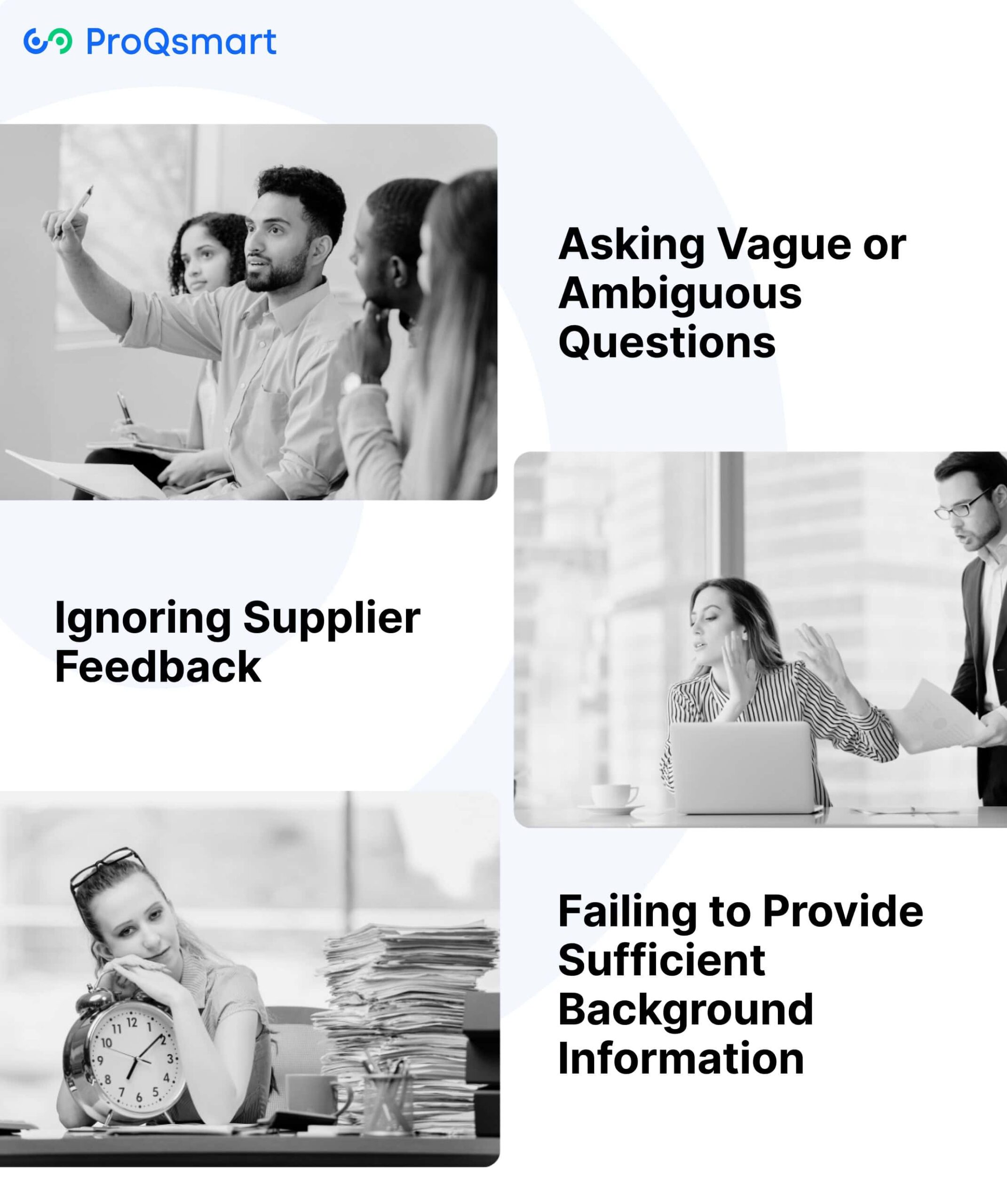A Request for Information (RFI) serves as a vital tool for organizations seeking to gather detailed insights from potential suppliers. This formal document allows procurement professionals to evaluate vendor capabilities, collect market data, and align solutions with specific business needs.
By utilizing RFIs, organizations can streamline the vendor selection process, ensuring that they make informed decisions based on comprehensive information. This approach not only promotes transparency and fosters healthy competition among suppliers but also saves valuable time by narrowing down options before progressing to Requests for Proposals (RFPs) or Requests for Quotations (RFQs).
In this article, we will explore best practices for crafting effective RFIs that enhance communication and facilitate better procurement outcomes.
Role of RFIs in Procurement
-
Streamlining Procurement Tasks: RFIs centralize and standardize procurement activities, allowing organizations to gather structured information about products and services, which enhances efficiency in vendor selection—often by up to 40%.
-
Establishing Communication with Vendors: RFIs facilitate open lines of communication between organizations and potential suppliers, enabling vendors to present their capabilities and tailor offerings to meet organizational goals, thus laying the groundwork for strong partnerships.
-
Gaining Market Insights: RFIs provide valuable insights into market trends and supplier capabilities, allowing procurement teams to identify innovative solutions and emerging technologies that can enhance business operations and maintain a competitive edge.
-
Contributing to Risk Management: RFIs help organizations vet potential suppliers early in the procurement process, assessing their reliability and compliance with industry standards, which is crucial for sectors like healthcare and manufacturing to ensure safety and regulatory adherence.
How to Write an Effective RFI

Each RFI should be tailored to the issuing organization and its particular needs, ensuring it addresses their specific goals and service requirements. There are some critical practices that can make it effective.
1. Define Clear Objectives
Setting clear goals and objectives is fundamental to the success of a Request for Information (RFI). Well-defined goals not only establish the tone and direction of the document but also influence its structure. For instance, if your organization is evaluating supplier capabilities to establish a new manufacturing line, it is essential to formulate targeted questions that probe deeply into technical expertise and capacity.
Aligning RFI objectives with your overall procurement strategy is crucial, ensuring that the information gathered through the RFI process is relevant and directly supports decision-making. Establishing measurable outcomes—such as identifying three qualified suppliers to advance to the next phase—provides a clear framework for evaluating the success of the RFI. By maintaining a focused approach, organizations can maximize the effectiveness of their RFIs and enhance their procurement processes.
2. Provide Detailed Context
Giving suppliers comprehensive background information up front will go a long way in getting the most accurate and tailored responses. Here are some examples of what to include: If your company is working on a sustainable build, list your project goals, preferred materials, and environmental guidelines.
When suppliers know what’s in scope and out of scope, they can offer the right solutions to meet your needs. Providing clear context increases supplier interest and engagement with your RFI, because vendors will be engaged to respond in a meaningful way to clear and well-defined requests.
3. Use Concise and Specific Language
RFIs should be written in direct, easy to follow language to minimize misinterpretation. Rather than asking, “What services do you have available? For example, you can ask, “What sustainable material sourcing services can you offer for multimillion-dollar projects?
Using industry-specific terminology, where appropriate, makes sure that suppliers are able to accurately identify your needs. Clear, concise language will not only result in higher quality responses, but a greater chance of receiving timely responses.
4. Include Relevant Questions
Writing questions that get straight to the heart of what you need for your project is key. For instance, if you’re looking to evaluate how a solution manages subcontractors, you may want to ask, “How does your platform automate pre-qualifications for subcontractors?
This process will help you to produce responses that are truly meaningful and actionable. Stay away from open-ended questions, as these result in unrelated or missing data. Thoroughly thought-out questions show your professionalism, which will help your suppliers respond in kind.
5. Utilize Structured Templates
Using structured templates ensures RFIs are completed in a standardized manner, saving an incredible amount of time while ensuring consistency. They let you issue unambiguous requirements that make it easy to compare supplier responses in a uniform format.
For example, templates can have pre-existing sections for company history, practice area expertise, and minority or women-owned business certifications. ProQsmart, an AI-powered procurement platform, provides customizable templates for use that meet the unique needs of any given project. This makes the entire process more efficient, promotes transparency, and guarantees that all relevant information has been collected.
6. Ensure Consistency in Format
Keeping a consistent format across the whole RFI improves clarity and makes comparing submissions easier. Use standardized sections, like “Vendor Information,” “Project Requirements,” and “Questions.
This type of consistency will go a long way towards making sure every response can quickly and easily be reviewed and compared. Adhering to these best practices helps promote a sense of professionalism and clarity, so that suppliers can best deliver what you’re looking for.
7. Review and Refine Before Sending
Preview an RFI before sending, so you have time for a careful second review to catch mistakes and missing information. Edit copy for clarity and review with team members to make sure the document is as complete as possible.
Be sure you’re covering all the bases with your RFI. This is critically important if you are looking for information on how to source capital expenditure. A thoroughly vetted RFI prevents a lot of confusion and focuses your RFI to get the best quality responses from suppliers.
Best Practices for RFIs
Request for Information (RFI) documents serve as invaluable assets in the financial services industry for acquiring vital supplier information during the procurement lifecycle. Beyond facilitating supplier evaluation, a well-structured RFI lays the foundation for successful vendor partnerships and critical initiatives. Here are best practices to develop effective RFIs, ensuring you focus on relevant solutions and move the process along efficiently.
Focus on Clarity and Simplicity
An RFI needs to be written in plain language to ensure clarity and avoid misunderstanding. By employing straightforward language, you eliminate the possibility of incorrect assumptions and ensure suppliers understand your specific service needs. Skip the acronyms and technical jargon, and articulate your requirements in layman’s terms, including an action step. Consistent and clear communication fosters a positive perception among suppliers, allowing them to provide accurate and relevant solutions in response to your request.
Tailor Requests to Vendors’ Expertise
Customization is the most important ingredient to an effective RFI. Aligning the document to the level of detail and capability you expect from the potential vendors will help make sure the answers you receive will meet your needs.
Knowing each vendor’s strengths and weaknesses is key. Doing some upfront research on what suppliers may be able to offer can help you frame requests that are tailored to their specialties. This way, you prompt suppliers to give answers that highlight their specialized knowledge instead of cookie cutter capabilities.
Avoid Overloading with Unnecessary Details
Over-asking suppliers of information available elsewhere, or that are regularly privy to a supplier, can inundate suppliers. This will lead to lower quality responses. Avoid overloading the RFI with “nice to have” requirements that clutter the response and risk adding confusion and complication. Rather than describe every technical feature of a project, zero in on what’s most important.
Identify issues that affect vendor selection, such as limited budgets and non-negotiable deadlines. When RFIs are loaded with unnecessary detail, it usually results in a game of telephone. Cutting the clutter to focus in on the important stuff gets everyone more quickly to the information that matters most.
This process honors everyone’s time and resources, from your internal team to the responding suppliers.
Set Realistic Deadlines for Responses
Creating reasonable timelines for RFI responses is arguably the most important step in the process. When provided with reasonable deadlines, vendors are more likely to submit thoughtful, high-quality responses. Allowing 2–3 weeks for responses allows your vendors to put their best foot forward. This gives them a chance to deeply understand your needs and craft more thoughtful responses.
Taking into account vendor workloads is just as important. Most suppliers have multiple clients and projects to manage, so offering more time shows a recognition of their realities of operation. Explicitly communicated timelines for submission are critical to prevent confusion and disappointment.
Managing Vendor Responses Efficiently

Proper managing vendor responses while going through the RFI process is key. It provides for a clear, fair and efficient process. Through the use of a more systematic method, procurement specialists can accelerate the evaluation process, encourage greater engagement, and develop better relationships built on trust with suppliers.
Here, we explore best practices for efficiently managing vendor responses, backed by data-driven takeaways.
Organize Submissions Systematically
A clear process for managing vendor responses is critical to keep everyone organized and moving efficiently. Sorting submissions according to defined criteria makes it easier to make comparisons. Pursuing this strategy allows for a tighter, more directed evaluation process.
Maintaining careful documentation of all submissions is equally essential. Important information, such as submission dates and contact details, should be tracked meticulously to create a consistent reference line for all subsequent phases. This greatly reduces the risk of oversight during critical initiatives.
Utilizing a centralized system, like ProQsmart’s AI-driven platform, can significantly alleviate document management burdens and enhance communication tracking. For example, ProQsmart’s e-tendering feature automatically aggregates and archives all RFI responses, providing superior transparency and access to crucial data.
Evaluate Responses Against Criteria
Clear evaluation criteria form the backbone of an objective assessment process in the financial services industry. These criteria should align with the organization’s procurement goals, such as cost-effectiveness, sustainability, or supplier scalability. For example, evaluating vendors based on their track record in timely deliveries or compliance with industry certifications provides measurable benchmarks for critical initiatives.
Consistency in applying these criteria across all submissions is central to fairness and to avoiding bias or favoritism. This involves everything from standardizing scoring rubrics to ensuring everyone evaluating proposals has the same clear understanding of the scoring criteria, which is essential for effective management platform.
Software solutions such as ProQsmart offer tools to automate vendor evaluations, allowing you to increase accuracy and consistency while minimizing manual effort. By grounding decisions in pre-defined metrics, procurement professionals can make informed choices that align with strategic objectives and operational needs, facilitating better financial assistance decisions.
Communicate Feedback Promptly
Providing feedback in a timely manner isn’t just polite – it’s the best way to build strong supplier relationships that foster creativity and innovation. Providing timely notice to vendors on the status of their submissions displays a high level of professionalism and respect.
For instance, providing timely feedback on lost proposals can give vendors the chance to improve their future responses. Being transparent about the feedback process builds long-term goodwill. Sharing this constructive feedback is important.
By identifying what could be improved and giving a few examples of excellent responses, you’re allowing vendors to better understand what you’re looking for. This transparency can help foster long-term partnerships and drive better supplier performance.
Maintain Transparency with Vendors
Open communication during the entire RFI process is key to building powerful supplier partnerships. Providing transparency into the evaluation process, the selection criteria, and the ultimate results allows vendors to grasp how decisions are made and fosters goodwill and trust.
For instance, giving bidders a detailed summary of their scores by category gives them transparency and lowers the chance of contentiousness. Communicating next steps, such as when you’ll award a contract or when you plan to reengage, increases professionalism.
This strategy further ensures that suppliers remain engaged in the process. Real-time, on-the-same-page collaboration and supplier performance monitoring capabilities on ProQsmart’s platform make transparency easy. It provides vendors with immediate access to relevant updates and evaluations, simplifying the whole process.
Common Mistakes to Avoid in RFIs

Common mistakes can severely weaken the impact of financial services, leading to wasted taxpayer dollars and missed opportunities. Avoiding these mistakes will enhance the efficiency and outcomes of your RFIs, maximizing their value.
Asking Vague or Ambiguous Questions
The most common error on RFIs comes from having vague or confusing questions. If questions are vague, suppliers may find it impossible to understand what you are looking for, leading to responses that are incomplete or off-target. If you ask a supplier to “describe your capabilities”, you’ll often get back answers that are not useful.
You need to define the use case, such as logistics, product development, or regulatory compliance, to get helpful insights. Vague inquiries do a disservice to the suppliers, and more importantly, limit participation. At worst, this will lead suppliers to question your readiness or professionalism, which will lead them to be less willing to engage fully.
Ignoring Supplier Feedback
One major mistake in the RFI process is the complete dismissal of supplier feedback. Supplier feedback is usually full of valuable insights that can help you refine your approach to procurement or achieve better project outcomes. For example, if multiple suppliers highlight the same challenge, such as unrealistic timelines or insufficient information, it’s a signal to reassess your requirements or communication methods.
Ignoring supplier feedback results in poor RFIs and leaves a bad taste in supplier relationships. By engaging suppliers early and actively in the RFI process, you set the stage for collaboration and trust. For instance, when developing new RFIs, integrating supplier feedback to create better RFIs shows a desire to improve with every iteration.
Failing to Provide Sufficient Background Information
An RFI without the necessary context and clarity on your goals risks derailing the entire process. If you don’t provide a clear picture of what you’re hoping to achieve, suppliers will come back with responses that don’t meet your specifications. For example, if you are sourcing materials for a construction project, include project timelines, location, and sustainability requirements to ensure alignment with your financial services needs.
Leveraging Technology to Enhance RFIs
The RFI process is a critical component of procurement. It provides organizations a standardized framework to gather essential information from prospective vendors, allowing them to compare and contrast options and make sound decisions. For many teams, the current RFI process brings inefficiencies that weigh them down, including the need for manual tracking and disjointed communication.
Procurement professionals can enhance the quality and effectiveness of their RFIs while building better relationships with suppliers—all by leveraging technology. Below, we explore a few major ways that technology improves the RFI experience.
Benefits of E-Sourcing Solutions
E-sourcing solutions make it easier to manage RFIs in one central platform, saving you time and effort coordinating submissions from dozens of potential vendors. These tools allow procurement teams to gather, evaluate, and contrast vendor answers much more quickly and thoroughly. For instance, ProQsmart’s e-tendering functionality quickly enables electronic bidding and equips you with the right tools to manage documents smoothly, enhancing the overall financial services industry.
Real-time tracking of all vendor submissions is another benefit of e-sourcing tools, providing procurement teams with an easy way to track submissions as they’re happening. With this visibility, users can quickly identify delays or gaps, ensuring timely follow-ups. Enhanced response rates and response quality are other important benefits that contribute to effective financial assistance.
By leveraging automated reminders and structured templates to help prompt vendors, advanced platforms help produce more robust and actionable submissions. E-sourcing increases overall procurement efficiency by cutting down on administrative functions and delivering actionable insights related to payments needs.
For instance, RFIs allow teams to compare vendor solutions effectively, aligning decisions with strategic goals like cost reduction or innovation. ProQsmart’s supplier performance monitoring capabilities lend a hand to this, providing a holistic review of historical data, resulting in stronger relationships over time.
Features to Streamline the RFI Process
Effective RFI management software includes several essential features:
- Automated notifications and reminders
- Real-time collaboration tools
- Advanced reporting and analytics
- Integration with existing procurement systems
Intuitive design creates a low barrier to entry that allows teams to start using the software almost immediately without the need for a long training session. ProQsmart offers you powerful analytics tools.
These solutions enable users to analyze RFI data, improve decision-making across the board, and reduce inventory holding costs by up to 18%. RFIs that allow seamless integration with existing systems are more likely to improve workflow efficiency.
Features, such as subcontractor management and bill of quantities tracking, better align procurement processes, reducing keying errors and bottlenecks.
Automating Notifications and Tracking
Automation may prove to be key for both accountability and efficiency when it comes to enhancing RFIs. Automated notifications help vendors stay on top of deadlines, and tracking tools let you easily make sure you have a record of every submission.
Providing timely updates creates a culture of engagement with your suppliers, which helps create more collaborative partnerships. ProQsmart really shines here by providing real-time collaboration, ensuring that all stakeholders are always on the same page throughout the process.
Conclusion
RFIs are a critical step in steering municipalities towards fruitful and clarifying vendor relationships. Writing them effectively the first time saves time, money, and clarifies confusion. Getting and keeping attention on the right details, asking the right questions, and being equipped to leverage technology can help make the process both efficient and seamless. Strong RFIs pave the way for fruitful partnerships and more creative, informed decisions.
By avoiding common pitfalls and adhering to best practices, you can ensure the greatest chance of success for your team. Clear communication and thoughtful planning can go a long way. With tools and savvy smart strategies, you can get a head start on planning for and handling a tsunami of vendor responses.
Start enhancing your strategic sourcing initiatives today. By adopting the right approach, you not only foster healthier supplier ecosystems but also create meaningful outcomes for your organization. Discover how ProQsmart can streamline your RFI process and elevate your procurement strategy. Book a demo now to see how our platform can help you achieve greater efficiency and effectiveness in your sourcing efforts!




